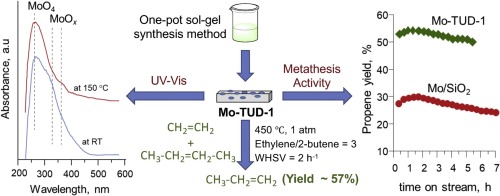Catalysis Today ( IF 5.2 ) Pub Date : 2019-04-01 , DOI: 10.1016/j.cattod.2019.03.073 Anoop Uchagawkar , Anand Ramanathan , Yongfeng Hu , Bala Subramaniam

|
Employing a one-pot sol-gel synthesis technique, molybdenum with variable loadings (2–14 wt%), was successfully incorporated into a mesoporous TUD-1 silicate framework. Diffuse reflectance UV–vis and Raman spectra of samples dehydrated at reaction temperatures (450 °C) revealed the dominant presence of highly dispersed tetrahedral di-oxo (Si-O)2Mo(=O)2 species. Neither bulk nor crystalline MoO3 was evident at Mo loadings from 2 to 7 wt.% from complementary analytical techniques suggesting that a high dispersion of MoOx species is achieved by this synthesis method. Mo L-edge XANES of catalyst samples at ambient conditions and Mo K-edge XAS of catalyst samples dehydrated at the reaction temperature (450 °C) further confirm the existence of mixed tetrahedral and octahedral Mo sites. The relative population of dioxo Mo species observed in Mo-TUD-1 catalysts at various Mo loadings correlate well with the Lewis acidity and apparent TOFs (mmol propene/mol Mo/s) observed with these samples. These observations confirm that the dioxo Mo species are the active site precursors, as also reported previously with other Mo-based catalyst formulations. Compared to Mo-impregnated SiO2 (Mo/SiO2) catalyst, the Mo-TUD-1 catalysts (2–7 wt% Mo loadings) provide higher apparent TOFs. At higher Mo loadings, the fraction of MoO3 species that are Brønsted acidic in nature increases, resulting in decreased TOFs and increased catalyst deactivation due to the formation of heavier hydrocarbons that deposit on the catalyst surface. However, the metathesis activity is fully restored after simple air regeneration of the catalyst.
中文翻译:

高度分散的含介孔硅酸盐的钼(Mo-TUD-1)用于烯烃复分解
采用一锅法溶胶-凝胶合成技术,将可变负载(2–14 wt%)的钼成功地掺入了介孔的TUD-1硅酸盐骨架中。在反应温度(450°C)下脱水的样品的漫反射紫外可见光谱和拉曼光谱表明,高度分散的四面体二-氧代(Si-O)2 Mo(= O)2物质占主导地位。根据补充分析技术,当Mo负载量为2至7 wt。%时,无论是块状MoMo 3还是晶体MoO 3都不明显,这表明MoO x的高分散性通过这种合成方法可以实现各种物种。在环境条件下催化剂样品的Mo L-edge XANES和在反应温度(450°C)下脱水的催化剂样品的Mo K-edge XAS进一步证实了存在混合的四面体和八面体Mo位点。在Mo-TUD-1催化剂中,在各种Mo负载下观察到的二氧Mo物种的相对种群与路易斯酸度和在这些样品中观察到的表观TOF(毫摩尔丙烯/摩尔Mo / s)具有很好的相关性。这些观察结果证实了二氧羰基Mo物种是活性位点的前体,正如先前在其他基于Mo的催化剂配方中所报道的那样。与Mo浸渍的SiO 2(Mo / SiO 2)催化剂,Mo-TUD-1催化剂(Mo含量为2-7 wt%)可提供更高的表观TOF。在较高的Mo负载下,本质上为酸性的MoO 3物种的比例增加,由于沉积在催化剂表面的重烃的形成,导致TOF降低和催化剂失活增加。然而,在催化剂的简单空气再生之后,复分解活性被完全恢复。











































 京公网安备 11010802027423号
京公网安备 11010802027423号